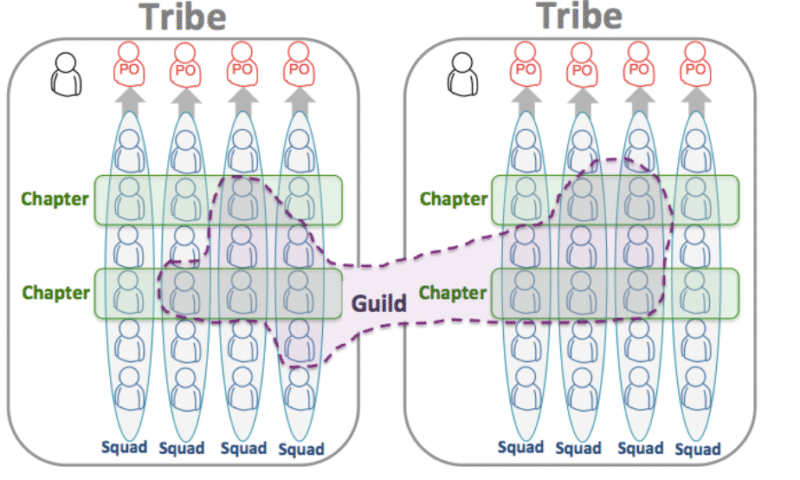Understanding Tribes, Guilds, Pods/Squads in Agile
When working with large enterprises, understanding the organizational constructs of scaled Agile delivery – Tribes, Guilds, Pods, ARTs, PI Planning, and more – is critical. These aren’t just buzzwords; they define how data, analytics, and product teams operate together at scale under frameworks like SAFe (Scaled Agile Framework) or Spotify Model (which many organizations have blended).
Let’s unpack everything in simple, visual-friendly terms
Big Picture: Why These Structures Exist
When Agile scaled beyond small software teams, companies realized:
- One team can’t own end-to-end delivery for large systems.
- But dozens of Agile teams working in silos = chaos.
- Hence, Scaled Agile introduced structures that balance autonomy + alignment.
That’s where Tribes, Pods, Guilds, ARTs, Value Streams, and Chapters come in.
Key Organizational Constructs in SAFe + Spotify-style Agile
| Term | Origin | What It Means | Typical Use in D&A / Tech Organizations |
|---|---|---|---|
| Pod | Spotify model | A small, cross-functional team (6–10 people) focused on a single feature, domain, or use-case. | e.g., “Revenue Analytics Pod” with Data Engineer, BI Developer, Data Scientist, Product Owner. |
| Squad | Spotify model | Similar to a Pod — autonomous Agile team that delivers end-to-end functionality. | e.g., “Guest Personalization Squad” responsible for AI-driven recommendations. |
| Tribe | Spotify model | A collection of related Pods/Squads working on a common business domain. | e.g., “Customer 360 Tribe” managing all loyalty, guest data, and personalization products. |
| Chapter | Spotify model | A functional community across squads — ensures consistency in technical skills, tools, and best practices. | e.g., Data Engineering Chapter, BI Chapter, Data Science Chapter. |
| Guild | Spotify model | A community of interest that cuts across the org — informal learning or best-practice sharing group. | e.g., Cloud Cost Optimization Guild, AI Ethics Guild. |
| ART (Agile Release Train) | SAFe | A virtual organization (50–125 people) of multiple Agile teams aligned to a common mission & cadence (PI). | e.g., “D&A Platform ART” delivering all analytics platform capabilities. |
| Value Stream | SAFe | A higher-level grouping of ARTs focused on delivering a business outcome. | e.g., “Customer Experience Value Stream” containing ARTs for loyalty, personalization, and customer analytics. |
| PI (Program Increment) | SAFe | A fixed timebox (8–12 weeks) for ARTs to plan, execute, and deliver. | Enterprises do PI Planning quarterly across D&A initiatives. |
| RTE (Release Train Engineer) | SAFe | The chief scrum master of the ART — facilitates PI planning, removes impediments. | Coordinates between multiple pods/squads. |
| Product Owner (PO) | Agile | Owns the team backlog; defines user stories and acceptance criteria. | Often aligned with one pod/squad. |
| Product Manager (PM) | SAFe | Owns the program backlog (features/epics) and aligns with business outcomes. | Defines strategic direction for ART or Tribe. |
| Solution Train | SAFe | Coordinates multiple ARTs when the solution is large (enterprise-level). | e.g., Enterprises coordinating multiple ARTs for org-wide data modernization. |
| CoE (Center of Excellence) | Enterprise term | A centralized body for governance, standards, and enablement. | e.g., Data Governance CoE, AI/ML CoE, BI CoE. |
What is unique with Spotify-model?
The Spotify model champions team autonomy, so that each team (or Squad) selects their framework (e.g. Scrum, Kanban, Scrumban, etc.). Squads are organized into Tribes and Guilds to help keep people aligned and cross-pollinate knowledge. For more details on this, I encourage you to read this article.
There is also one more useful material on Scaling Agile @ Spotify.

Simplified Analogy
Think of a cruise ship 🙂
| Cruise Concept | Agile Equivalent |
|---|---|
| The Ship | The Value Stream (business goal) |
| Each Deck | An ART (Agile Release Train) – a functional area like Guest Analytics or Revenue Ops |
| Each Department on Deck | A Tribe (Marketing, Data, IT Ops) |
| Teams within Department | Pods/Squads working on features |
| Crew with Same Skill (Chefs, Engineers) | Chapters – same skill family |
| Community of Passion (Wine Enthusiasts) | Guilds – voluntary learning groups |
| Captain / Officers | RTE / Product Manager / Architects |
In a Data & Analytics Organization (Example Mapping)
| Agile Construct | D&A Example |
|---|---|
| Pod / Squad | Loyalty Analytics Pod building retention dashboards and models. |
| Tribe | Customer 360 Tribe uniting Data Engineering, Data Science, and BI pods. |
| Chapter | Data Quality Chapter ensuring consistent metrics, lineage, and governance. |
| Guild | AI Experimentation Guild sharing learnings across data scientists. |
| ART | D&A Platform ART orchestrating data ingestion, governance, and MLOps. |
| PI Planning | Quarterly sync for backlog prioritization and dependency resolution. |
| RTE / PM | Ensuring alignment between business priorities and data delivery roadmap. |
Summary
- Pods/Squads → Smallest Agile unit delivering value.
- Tribes → Group of pods delivering a shared outcome.
- Chapters → Skill-based group ensuring quality & standards.
- Guilds → Interest-based communities sharing best practices.
- ARTs / Value Streams → SAFe structures aligning all of the above under a common business mission.
- PI Planning → The synchronization event to plan and execute at scale.

